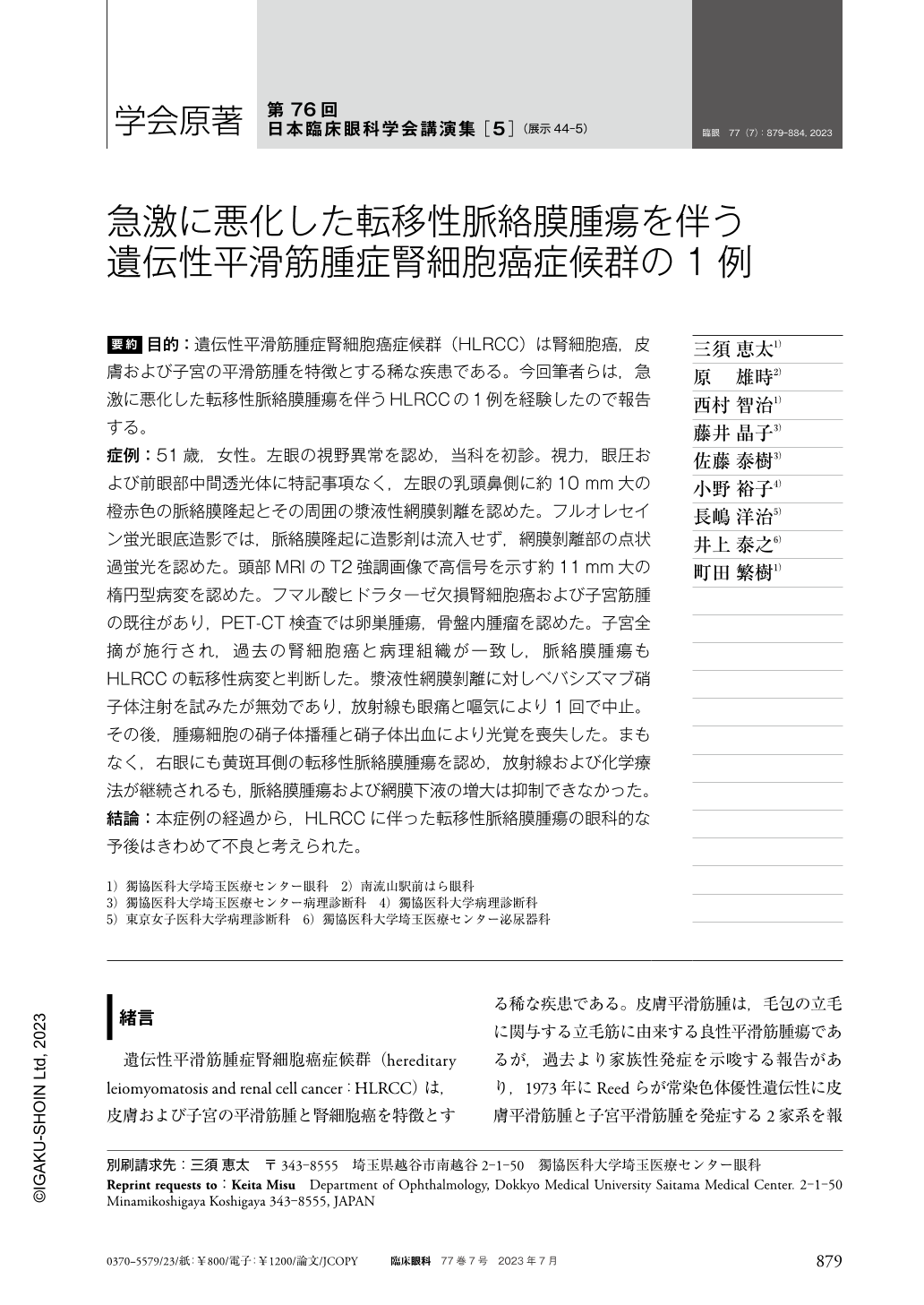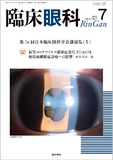Japanese
English
- 有料閲覧
- Abstract 文献概要
- 1ページ目 Look Inside
- 参考文献 Reference
要約 目的:遺伝性平滑筋腫症腎細胞癌症候群(HLRCC)は腎細胞癌,皮膚および子宮の平滑筋腫を特徴とする稀な疾患である。今回筆者らは,急激に悪化した転移性脈絡膜腫瘍を伴うHLRCCの1例を経験したので報告する。
症例:51歳,女性。左眼の視野異常を認め,当科を初診。視力,眼圧および前眼部中間透光体に特記事項なく,左眼の乳頭鼻側に約10mm大の橙赤色の脈絡膜隆起とその周囲の漿液性網膜剝離を認めた。フルオレセイン蛍光眼底造影では,脈絡膜隆起に造影剤は流入せず,網膜剝離部の点状過蛍光を認めた。頭部MRIのT2強調画像で高信号を示す約11mm大の楕円型病変を認めた。フマル酸ヒドラターゼ欠損腎細胞癌および子宮筋腫の既往があり,PET-CT検査では卵巣腫瘍,骨盤内腫瘤を認めた。子宮全摘が施行され,過去の腎細胞癌と病理組織が一致し,脈絡膜腫瘍もHLRCCの転移性病変と判断した。漿液性網膜剝離に対しベバシズマブ硝子体注射を試みたが無効であり,放射線も眼痛と嘔気により1回で中止。その後,腫瘍細胞の硝子体播種と硝子体出血により光覚を喪失した。まもなく,右眼にも黄斑耳側の転移性脈絡膜腫瘍を認め,放射線および化学療法が継続されるも,脈絡膜腫瘍および網膜下液の増大は抑制できなかった。
結論:本症例の経過から,HLRCCに伴った転移性脈絡膜腫瘍の眼科的な予後はきわめて不良と考えられた。
Abstract Purpose:Hereditary leiomyomatosis and renal cell cancer(HLRCC)is a rare disorder characterized by renal cell carcinoma and leiomyomas of the skin and uterus. We report a case of HLRCC with rapidly deteriorating choroidal metastasis.
Case:A 51-year-old woman initially visited our department complaining of visual field abnormality in the left eye. There were no remarkable findings related to visual acuity, intraocular pressure, anterior segment, and ocular media. An orange-red choroidal elevation approximately 10 mm in diameter, surrounded by a serous retinal detachment, was observed on the nasal side of the optic disc in the left eye. Fluorescein angiography showed spotty hyperfluorescence in the area of the retinal detachment with no contrast flow into the choroidal ridge. T2-weighted image of the head MRI showed an approximately 11 mm large oval lesion with high signal. The PET-CT scan showed ovarian tumor and pelvic seeding. Total hysterectomy was performed, and the histopathological findings were consistent with those of a previous renal carcinoma, suggesting that the choroidal tumor was a metastatic lesion of HLRCC. Intravitreal bevacizumab was administered to treat the serous retinal detachment without favorable response. Radiotherapy was ceased after one session due to ocular pain and nausea. Subsequently, tumor cell seeding in the vitreous and vitreous hemorrhage resulted in loss of light perception. Soon after, choroidal metastasis was found in the right eye on the temporal side of the macula. Radiotherapy and chemotherapy were continued, but the growth of the choroidal metastasis and subretinal fluid could not be controlled.
Conclusion:The aggressive progression of the lesion despite treatment indicated the unfavorable prognosis of choroidal metastasis secondary to HLRCC.

Copyright © 2023, Igaku-Shoin Ltd. All rights reserved.


